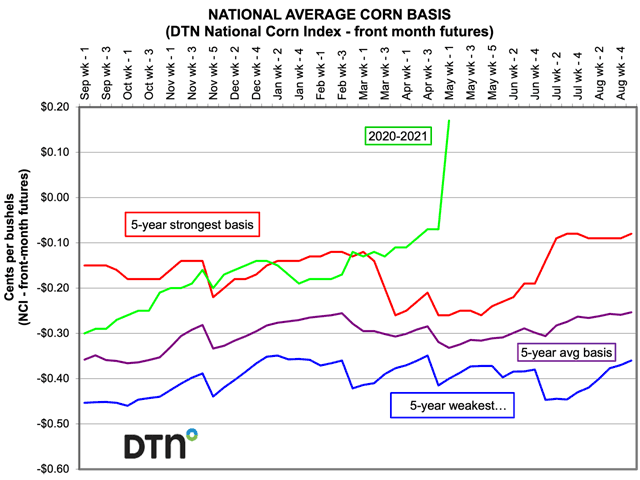Cash Market Moves
National Average Corn Basis at a Weekly High Not Seen Since 2013
The DTN national average corn basis on April 30 was 18 cents over the July futures -- a new high not seen since the second week in April of the 2012-13 crop year. Since the beginning of the 2020-21 crop year, average corn basis has been above the DTN national average five-year basis, similar to the way it ended the 2019-20 crop after recovering midsummer from a first week of May pandemic low of 32 cents under the July.
Cash prices have been on fire since mid-January when DTN's National Corn Index reached a seven-year high, as basis levels stayed firm in spite of rising futures. Demand at that time was picking up on the West Coast as corn exports for the crop year 2020-21 started to pick up to Mexico, Japan, Korea and China.
The other factor strengthening U.S. corn prices was a slow planting season for the second corn crop in Brazil and currently dry weather likely cutting yield potential's there. John Baranick, DTN meteorologist, wrote on April 29 that, "Another week has gone by, but the forecast has not changed for Brazil. The majority of Brazil's growing regions now have soil moisture readings of no more than 50% capacity. The only exception is a strip in far western Mato Grosso do Sul that saw slightly increased soil moisture from weekend showers. The second-crop (safrinha) corn is forced to pull more and more of that soil moisture out of the subsoil as there has been little to no replenishment at the surface during the last several weeks." https://www.dtnpf.com/…
Given that the supplies of corn in the U.S are dwindling amid strong export and domestic demand, the markets are continuing to move to new highs. In the April 9 World Agricultural Supply and Demand Estimates (WASDE) report, USDA estimated lower ending stocks for U.S. corn in 2020-21 at 1.352 billion bushels, a seven-year low.
Yet, demand has not budged. Besides export demand, domestic demand is driving the strength in the basis and futures. Ethanol plants have been staging a strong recovery versus the same time last year when the pandemic slowed or shuttered plants, with more than one half of the nation's ethanol production capacity idled.
P[L1] D[0x0] M[300x250] OOP[F] ADUNIT[] T[]
According to the Energy Information Administration (EIA) in a June 8, 2020, report, U.S. fuel ethanol production fell dramatically during late March and in April 2020, driven by significant reductions in motor gasoline demand as a result of mitigation efforts for the 2019 novel coronavirus disease (COVID-19). "Fuel ethanol production fell to 537,000 barrels per day (bpd) in the week ended April 24, 2020, which was the lowest level on record since June 2010, when the EIA began collecting weekly fuel ethanol production data. Because almost all finished motor gasoline sold in the United States is blended with 10% ethanol (E10), the drop in gasoline demand drove similar decreases in fuel ethanol demand, and correspondingly, fuel ethanol production," noted the EIA.
As of April 2021, ethanol production has recovered to approximately 90% of pre-pandemic levels or 950,000 bpd. That means increased production created the need for cash corn, and as futures corn prices rose, so did the basis, causing the overall cash price to surge as ethanol plants bid for old-crop corn in additions to feeders and exporters.
Here's a sampling of what the spot yellow cash corn price has done at various ethanol plants using daily data from the USDA. In the Eastern Corn Belt, representing plants in Illinois, Indiana, Ohio and Michigan, the truck cash price for April 30 was $6.78 versus $6.24 one week ago and $2.97 one year ago. In Nebraska, the truck cash price for April 30 was $6.67 versus $6.11 one week ago and $2.79 one year ago. In Iowa, the truck cash price for April 30 was $6.38 versus $6.02 one week ago and $2.49 one year ago. In South Dakota, the truck cash price for April 30 was $6.70 versus $6.14 one week ago and $2.60 one year ago.
So, the million-dollar question is: Will we run out of old-crop corn to fill the needs of all interested parties? In an April 23 article, "How Tight Are US Corn Supplies?" DTN Lead Analyst Todd Hultman addresses that subject:
Meanwhile, besides the rising futures prices, the basis is responding with a resounding "yes," as corn supplies are tight amid the nonstop demand.
Just how high can these prices go? Stay tuned.
Mary Kennedy can be reached at mary.kennedy@dtn.com
Follow her on Twitter @MaryCKenn
(c) Copyright 2021 DTN, LLC. All rights reserved.




